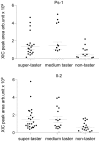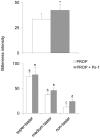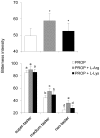Marked increase in PROP taste responsiveness following oral supplementation with selected salivary proteins or their related free amino acids
- PMID: 23555788
- PMCID: PMC3610910
- DOI: 10.1371/journal.pone.0059810
Marked increase in PROP taste responsiveness following oral supplementation with selected salivary proteins or their related free amino acids
Abstract
The genetic predisposition to taste 6-n-propylthiouracil (PROP) varies among individuals and is associated with salivary levels of Ps-1 and II-2 peptides, belonging to the basic proline-rich protein family (bPRP). We evaluated the role of these proteins and free amino acids that selectively interact with the PROP molecule, in modulating bitter taste responsiveness. Subjects were classified by their PROP taster status based on ratings of perceived taste intensity for PROP and NaCl solutions. Quantitative and qualitative determinations of Ps-1 and II-2 proteins in unstimulated saliva were performed by HPLC-ESI-MS analysis. Subjects rated PROP bitterness after supplementation with Ps-1 and II-2, and two amino acids (L-Arg and L-Lys) whose interaction with PROP was demonstrated by (1)H-NMR spectroscopy. ANOVA showed that salivary levels of II-2 and Ps-1 proteins were higher in unstimulated saliva of PROP super-tasters and medium tasters than in non-tasters. Supplementation of Ps-1 protein in individuals lacking it in saliva enhanced their PROP bitter taste responsiveness, and this effect was specific to the non-taster group.(1)H-NMR results showed that the interaction between PROP and L-Arg is stronger than that involving L-Lys, and taste experiments confirmed that oral supplementation with these two amino acids increased PROP bitterness intensity, more for L-Arg than for L-Lys. These data suggest that Ps-1 protein facilitates PROP bitter taste perception and identifies a role for free L-Arg and L-Lys in PROP tasting.
Conflict of interest statement
Figures





Similar articles
-
Taste Perception of Sweet, Sour, Salty, Bitter, and Umami and Changes Due to l-Arginine Supplementation, as a Function of Genetic Ability to Taste 6-n-Propylthiouracil.Nutrients. 2017 May 25;9(6):541. doi: 10.3390/nu9060541. Nutrients. 2017. PMID: 28587069 Free PMC article.
-
Dose-Dependent Effects of L-Arginine on PROP Bitterness Intensity and Latency and Characteristics of the Chemical Interaction between PROP and L-Arginine.PLoS One. 2015 Jun 23;10(6):e0131104. doi: 10.1371/journal.pone.0131104. eCollection 2015. PLoS One. 2015. PMID: 26103639 Free PMC article.
-
Responsiveness to 6-n-propylthiouracil (PROP) is associated with salivary levels of two specific basic proline-rich proteins in humans.PLoS One. 2012;7(2):e30962. doi: 10.1371/journal.pone.0030962. Epub 2012 Feb 1. PLoS One. 2012. PMID: 22312435 Free PMC article. Clinical Trial.
-
PTC/PROP tasting: anatomy, psychophysics, and sex effects.Physiol Behav. 1994 Dec;56(6):1165-71. doi: 10.1016/0031-9384(94)90361-1. Physiol Behav. 1994. PMID: 7878086 Review.
-
Genetic variation in taste sensitivity to 6-n-propylthiouracil and its relationship to taste perception and food selection.Ann N Y Acad Sci. 2009 Jul;1170:126-39. doi: 10.1111/j.1749-6632.2009.03916.x. Ann N Y Acad Sci. 2009. PMID: 19686122 Review.
Cited by
-
Genetic sensitivity to the bitter taste of 6-n-propylthiouracil (PROP) and its association with physiological mechanisms controlling body mass index (BMI).Nutrients. 2014 Aug 27;6(9):3363-81. doi: 10.3390/nu6093363. Nutrients. 2014. PMID: 25166026 Free PMC article. Review.
-
The role of carbonic anhydrase VI in bitter taste perception: evidence from the Car6⁻/⁻ mouse model.J Biomed Sci. 2014 Aug 19;21(1):82. doi: 10.1186/s12929-014-0082-2. J Biomed Sci. 2014. PMID: 25134447 Free PMC article.
-
Taste Perception of Sweet, Sour, Salty, Bitter, and Umami and Changes Due to l-Arginine Supplementation, as a Function of Genetic Ability to Taste 6-n-Propylthiouracil.Nutrients. 2017 May 25;9(6):541. doi: 10.3390/nu9060541. Nutrients. 2017. PMID: 28587069 Free PMC article.
-
The gustin (CA6) gene polymorphism, rs2274333 (A/G), as a mechanistic link between PROP tasting and fungiform taste papilla density and maintenance.PLoS One. 2013 Sep 9;8(9):e74151. doi: 10.1371/journal.pone.0074151. eCollection 2013. PLoS One. 2013. PMID: 24040192 Free PMC article.
-
Differences in Salivary Proteins as a Function of PROP Taster Status and Gender in Normal Weight and Obese Subjects.Molecules. 2021 Apr 13;26(8):2244. doi: 10.3390/molecules26082244. Molecules. 2021. PMID: 33924512 Free PMC article. Clinical Trial.
References
-
- Behrens M, Reichling C, Batram C, Brockhoff A, Meyerhof W (2009) Bitter taste receptors and their cells. Ann N Y Acad Sci 1170: 111–115. - PubMed
-
- Meyerhof W (2005) Elucidation of mammalian bitter taste. Rev Physiol Biochem Pharmacol 154: 37–72. - PubMed
-
- Shi P, Zhang J, Yang H, Zhang YP (2003) Adaptive diversification of bitter taste receptor genes in mammalian evolution. Mol Biol Evol 20: 805–814. - PubMed
-
- Meyerhof W, Batram C, Kuhn C, Brockhoff A, Chudoba E, et al. (2010) The molecular receptive ranges of human TAS2R bitter taste receptors. Chem Senses 35: 157–170. - PubMed
Publication types
MeSH terms
Substances
LinkOut - more resources
Full Text Sources
Other Literature Sources

